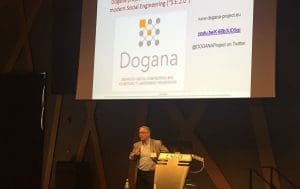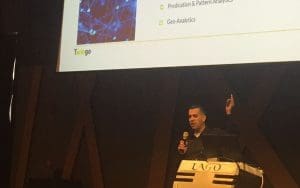This post is also available in:
 עברית (Hebrew)
עברית (Hebrew)
The consequences of the Big Data revolution in all the technological fields and the role of Artificial Intelligence (AI) with this regard were the focus of today’s fascinating conference and exhibition Big Data for Security and Intelligence at the Lago Conference Center in Rishon LeZion. The professional conference organized by iHLS for the sixth year gathered all the ecosystem – experts from the commercial sector, defense industries, the IDF and security organizations, investors, etc.
Visiting the impressing exhibition, the participants had the opportunity to witness the new developments at first hand.

As always, the conference was narrated by Col. (res.) Arik Davidi, formerly a Brigade Commander at the IDF Armored Corps, a court of appeals judge (res.) and the owner of a security consulting and homeland security company. Demonstrating the dimensions of big data, he said that until now, only 0.5% of the huge amounts of data collected globally were actually analyzed and processed.

The opening presentation by Lt. Col. Nurit Cohen Inger, Head of Sigma Branch, Matzpen, IDF, focused on the way the IDF advances AI, and its concept of data as an asset. Since Operation Protective Edge in 2014, the IDF has understood that AI, and later – Deep Learning – can help analyze patterns in big data and make forecasts regarding the battlefield. The IDF uses these technologies for various missions – from face recognition, object recognition in video in support of the lookout operators, to text analytics of field reports with the ability to understand the sentiment in order to alert forces in the field. Next year’s challenges will include speech-to-text for the tactical network. All these are integrated gradually, keeping man in the loop.

Until 2020, some 50 billion objects will supply information globally, creating huge amounts of data, said Benny Malka, Regional Territory Manager at DELL EMC, who spoke about the concept of data lakes. Thanks to AI, big data analytics is in fact possible. EMC helps organizations lead the revolution and make the data accessible.

According to Yudi Bar On, Head of Big Data Solutions Department at Rafael, the major goal in this field is turning the information into relevant intelligence and knowledge. This is attained by data fusion from various sources – visual, text, face and voice recognition, etc., in order to reach insights. Rafael’s Wisdom Stone platform is an end-to-end solution which started as a development for the military sector and is now offered also to the commercial market, including the integration of client’s algorithms in the systems and the use of open architecture.
Phishing cyber attacks have long deviated from the email realm and turned into a major component of malware. Dr. Nathan Weiss, Senior Scientist, Cyber Division, IAI, focused on the interface between big data and social engineering – criminal actors are using big data technologies for phishing attacks against individuals and computers, while cybersecurity teams are implementing big data in order to improve defenses. Elta is a partner in the European Horizon 2020 R&D program and is active within this framework in the Dogana project for cybersecurity against social engineering. In addition to big data, the solutions rely also on raising the awareness of the users.


Cybersecurity was also the subject of the presentation of Aviram Zrahia, Technology Consultant at Juniper Networks. He spoke about the next-generation detection technologies – intelligence that includes behavior identification and big data analytics by means of AI. Juniper offers an orchestration capability between the various systems under the same security system.

Ronen Gal, IBM’s Cognitive and Big Data Solutions Manager, elaborated on the latest innovations in the field of chatbots, a dialog that mimics conversation between people in natural language, currently including also visuals and audio.


Big data architecture structures without a central server that causes bottlenecks were presented by the CEO and Founder of Twingo, Golan Nahum. He also referred to big data applications in the cybersecurity field.



























